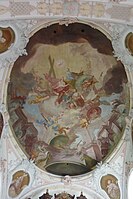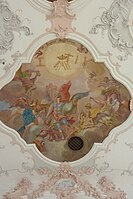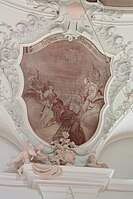St. Georg (Westendorf)
The Catholic parish church of St. Georg in Westendorf , a municipality in the Augsburg district in the Bavarian administrative district of Swabia , was built in the middle of the 18th century in the Rococo style. The substructure of the choir and tower have been preserved from the late Gothic predecessor church .
history
The origins of the parish can be traced back to the 7th century. In 1070 a chapel in honor of Mary and St. Gertrud occupied. The church patronage at that time lay with the Truchsessen von Kühlental , among whom a church was built at the current location in the 13th century at the latest, of which, however, no traces have been preserved. 1361 reached basic rule to the high pin Augsburg they until secularization held 1803rd
As can be seen from a building inscription, the previous Romanesque building was replaced by a new Gothic building in 1491. For the year 1491 it is also documented that Mary, St. Sebastian , St. Valentin and St. An altar was consecrated to Catherine. This altar consecration was done by Friedrich II von Zollern , who was Bishop of Augsburg from 1486 to 1505. Between 1664 and 1670 the tower and nave were renewed. After the nave walls and parts of the choir collapsed during repairs to the roof structure, the church had to be largely rebuilt in 1691.
Another new building took place in 1739/41 according to plans by the Tyrolean master builder Franz Xaver Kleinhans . With the stucco that were Wessobrunner Ignaz Finsterwalder and his brother Johann Baptist entrusted. The ceiling frescoes were created by Johann Georg Wolcker (1700–1766) from Burgau , who also executed the oil paintings on the oratorios and the balustrades . On 25 July 1759 took Vicar General Franz Xaver Adelmann of Adelmannsfelden the consecration before the new church. In 1998 the church was extensively renovated.
architecture
Exterior construction
In the northern corner of the choir rises the seven-story tower, the square substructure of which is broken up by twin arcades on the top floor . Over a segmentbogigen cornice sits a by Eck pilaster strip reinforced with a pointed Mansardhaube covered, octagonal structure, which is provided on four sides with arched sound openings and large dials.
Stairwells to be on the south side of the nave pulpit and southern oratorio grown, located on the north and west facade under sign the entrance portals . The windows of the choir side walls have unusual shapes. A smaller, heart-shaped window opens under a three-pass window.
inner space
The single-nave nave is divided into four axes and covered by a flat basket-arched barrel with stitch caps over the large arched windows. The walls of the nave are structured by double pilasters with volute capitals over which a profiled cornice runs. A more-stepped fighters resting chancel arch opens to the retracted choir of an oval Pendentif dome is covered. The western end of the nave is formed by a two - story organ loft supported by two columns , which is accessible via two walled-in spiral staircases .
Piece
A rich stucco decoration of putti , horns of plenty , flower vases and flower hangings adorns the ceilings and walls. Shell-work cartouches frame the windows and the smaller frescoes, which are connected by garlands of flowers . The life-size reliefs of the Twelve Apostles are located in shallow shell niches . The setting of the figures in polished white with partial gilding is intended to simulate an execution in marble .
Ceiling pictures
The choir fresco shows the award of the martyr's crown to St. Georg , the patron saint of the church. Archangel Michael is shown at the edge of the picture, holding the plan of the Westendorf church in his hand. The grisailles contain allegorical representations and scenes from the life of St. George.
The large nave fresco is dedicated to the spread of the rosary over the whole world. In the middle, Mary is enthroned on a cloud with the baby Jesus. St. Catherine of Siena and St. Dominic kneel at her feet , to whom Mary presents a rosary. The smaller frescoes have the praises of Mary according to the Lauretan litany on the subject. The fresco above the organ gallery bears the inscription: Regina Sanctorum Omnium (Queen of all saints). In addition to the evangelists and their symbols , St. Ignatius of Loyola , St. Ulrich and other saints are depicted.
organ
Today's organ was installed in 1969 by the organ building company Sandtner from Dillingen an der Donau . It is a mechanical slider chest organ . The main and pedal parts are housed in the parapet organ, the upper part stands as a positive above the console .
Furnishing
- The baptismal font is made of Solnhofen limestone from the previous church . It consists of a square base, an octagonal shaft with an Ionic capital and a shell-like basin. The year 1614 is carved below the capital.
- The wooden figure of John the Baptist on the north pillar of the choir arch is dated around 1720 and attributed to Joseph Anton Libigo.
- The neo-baroque high altar was created around 1900. The extract shows the beheading of St. George and was executed by Johann Georg Wolcker in 1740. The side figures are from 1755 and represent St. Sebastian and St. Fabian represents.
- The altar leaves of the two side altars were made by Johann Baptist Enderle in 1770/79 . The picture on the north altar represents St. Joseph , the image of the southern altar of St. Johannes Nepomuk . The figure of St. Christophorus on the right altar is a work by the sculptor Joseph Anton Libigo from around 1712.
- The pulpit was created by Johann Michael Bertele and installed in 1740/41. The pulpit body is decorated with the gilded evangelist symbols. The sound cover is crowned by the sculpture of the Archangel Michael, the rim is decorated with putti heads. The carved figures are attributed to Johann Michael Fischer .
- The cheeks of the pews , the three-seat choir stalls , the wood-carved confessionals were also made by Johann Michael Bertele in 1740/41.
- In addition to the frescoes, Johann Georg Wolcker also created the oil paintings depicting the seven sacraments (baptism of Jesus, confirmation of a young man, Lord's Supper, penance of the sinner Mary Magdalene, handing over of the keys to Peter as a symbol for the priestly ordination, the engagement of Mary to Joseph on behalf of the sacrament of the Marriage, anointing of the sick) and the paintings in the upper gallery depicting angels making music.
- The paintings of the Stations of the Cross were made by Franz Regis Göz in 1767. Stations VIII, XII, XIII and XIV were replaced with new pictures during the renovation in 1868.
literature
- Georg Dehio : Handbook of German Art Monuments - Bavaria III - Swabia (arr.: Bruno Bushart , Georg Paula ) . 2nd Edition. Deutscher Kunstverlag , Munich 1989, ISBN 978-3-422-03116-6 , p. 1079-1080 .
- Ingo Seufert: Catholic parish church St. Georg in Westendorf . Kunstverlag Josef Fink, Lindenberg 2005, ISBN 3-89870-257-X .
Web links
Individual evidence
Coordinates: 48 ° 34 ′ 23.2 " N , 10 ° 50 ′ 10.3" E











